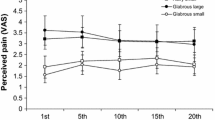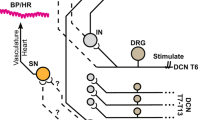Abstract
The influence of stimulus temperature rise rate (2.5ºC/s, 5.0ºC/s, and 10.0ºC/s), adapting (baseline) temperature (25ºC, 30ºC, and 35ºC), and duration of peak stimulus temperature (1.0 s, 2.5 s, 5.0 s, and 10.0 s) on responses evoked by noxious heat stimuli of suprathreshold intensity was studied in wide dynamic range (WDR) neurons of the rat spinal dorsal horn. The spinal neuronal responses were compared with human psychophysical data obtained using the same stimuli. Noxious heat stimuli with a peak temperature of 54ºC were applied with a contact thermostimulator to the glabrous skin of the hindfoot in rats or to the palmar skin in humans. With the highest ramp rate and the highest adapting temperature, the sensory and spinal neuronal response latencies were decreased more than expected on the basis of the change in physical parameters of the stimulus. The magnitudes of sensory and spinal neuronal response were independent of the stimulus ramp rate, whereas pain magnitude estimates and spinal neuronal impulse counts evoked by the same peak stimulus temperature were increased with an increase in the adapting stimulus temperature. The onset latencies of pain reactions and spinal neuronal responses were independent of the peak stimulus duration, whereas the latency of the maximum discharge in spinal neurons increased with prolongation of the peak stimulus. The sensory magnitude estimate of pain and the neuronal impulse count were increased with increase in stimulus duration. Following spinalization, the spinal neuronal responses were stronger and the stimulus duration-dependent increase in the impulse count developed faster. Moreover, the peak frequency of spinal neuronal response increased significantly with prolongation of the heat stimuli after spinalization, but not in animals with an intact spinal cord. The results indicate that stimulus rise rate, stimulus duration, and the adapting temperature are important factors in determining the sensory and spinal neuronal responses to high-intensity heat stimuli. The changes in the total impulse counts evoked by varying supraliminal heat stimuli in spinal dorsal horn WDR neurons corresponded well with the changes in pain magnitude estimates in humans. Also, the changes in spinal neuronal response onset latencies were accompanied by corresponding changes in onset latencies of human pain reactions but not with pain magnitude estimates. The effect of spinalization indicated that descending pathways control not only the response magnitude in the spinal dorsal horn WDR neurons but also the temporal characteristics of the spinal neuronal response.
Similar content being viewed by others
Author information
Authors and Affiliations
Additional information
Received: 24 August 1998 / Accepted: 25 January 1999
Rights and permissions
About this article
Cite this article
Pertovaara, A. The influence of stimulus temperature rise rate, adapting temperature, and stimulus duration on suprathreshold responses evoked by noxious heat in the glabrous skin of the limb Comparison of neuronal discharge in the rat spinal dorsal horn with human sensations. Exp Brain Res 126, 482–494 (1999). https://doi.org/10.1007/s002210050756
Issue Date:
DOI: https://doi.org/10.1007/s002210050756




